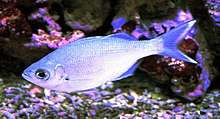Kuhlia xenura
Kuhlia xenura, the strange-tailed flagtail or Hawaii flagtail,, is a species of ray-finned fish, a flagtail from the family Kuhliidae which is endemic to Hawaii, where it occurs in fresh, brackish, and marine waters. It can be found in tide pools, estuaries, and on reefs occurring over sand or rock.
| Kuhlia xenura | |
|---|---|
 | |
| Scientific classification | |
| Kingdom: | Animalia |
| Phylum: | Chordata |
| Class: | Actinopterygii |
| Order: | Perciformes |
| Family: | Kuhliidae |
| Genus: | Kuhlia |
| Species: | K. xenura |
| Binomial name | |
| Kuhlia xenura (D. S. Jordan & C. H. Gilbert, 1882) | |
| Synonyms[1] | |
| |
Description
Kuhlia xenura has a slighty concave dorsal profile of the head in adults slightly concave with a large eye. The second spine in the anal fin is around 90% of the length of the third. The caudal fin is deeply forked. This species is silver in colour with a dark grey or dusky caudal fin which has a thin black rearr margin and it frequently shows a pale submarginal band.[2] The dorsal fin has 10 spines and 10 soft rays while the anal fin has 3 spines and 10-11 soft rays. This species grows to a standard length of 22.2 cm (8.7 in).[1]
Distribution
Kuhlia xenura is endemic to Hawaii.[1]
Habitat and biology
Kuhlia xenura is frequently observed in schools and can be found in fresh water, brackish habitats, and shallow water along the seashore. While in fresh water they feed mainly on algae, insects, planktonic crustaceans, and foraminiferans, while fish in brackish or salt water eat copepods, amphipods, insects, mollusc larvae, algae, spiders, and annelids. Medium sized fish, with a total length of 75–150 millimetres (3.0–5.9 in) occur in deeper water at the foot of exposed cliffs, in larger tidal pools, or in rivers or ponds. These fish have a diet dominated by crustacean larvae, especially the later stages of crabs and stomatopods, yjey aslso eat also small amounts of insects and algae. Fish greater than a total length of 150 millimetres (5.9 in) are found in surf exposed cliffs, in caves in outer reefs, and other exposed localities where they feed largely on crustaceans and polychaete worms. This species is mainly nocturnal. Spawning occurs all year, but peaks between December and June and it appears to occur at sea.[2]
Taxonomy
The strange-tailed flagtail was previously confused with the Hawaiian flagtail until 2001. It was first described as Xenichthys xenurus on the basis of a specimen mistakenly thought to have come from San Salvador, El Salvador.[3] For over a century, the name Xenichthys xenurus was overlooked in the literature and K. xenura was confused with K. sandvicensis by many authors.[4][5][6]
In 2001, the ichthyologist John Ernest Randall and his wife Helen Randall reviewed all nominal flagtail species from the Pacific Ocean. They found out that two species had been lumped together under Kuhlia sandvicensis, one of which had been misidentified as the freshwater K. marginata by some authors (the true K. sandvicensis). They found out that specimens of the common flagtail species from the Hawaiian Islands misidentified as K. sandvicensis matched the description of Xenichthys xenurus and thus Kuhlia xenura became the correct name for one of the two flagtail species from Hawaii.[2]>
References
- Froese, Rainer and Pauly, Daniel, eds. (2019). "Kuhlia xenura" in FishBase. December 2019 version.
- John E. Randall & Helen A. Randall (2001). "Review of the Fishes of the Genus Kuhlia (Percifonnes: Kuhllidae) of the Central Pacific" (PDF). Pacific Science. 55 (3): 227–256.
- Jordan, D. S. and C. H. Gilbert 1882. Description of a new species of Xenichthys (Xenichthys xenurus) from the west coast of Central America. Proceedings of the United States National Museum v. 4 (no. 252): 454.
- Gosline, W.A. and V.E. Brock, 1960. Handbook of Hawaiian fishes. University of Hawaii Press, Honolulu. 372 p. + 277 figs.
- Randall, J.E., 1985. Guide to Hawaiian reef fishes. Harrowood Books, Newtown Square, PA 19073, USA. 74 p.
- Randall, J.E., 1996. Shore fishes of Hawai'i. Natural World Press, Vida, Oregon. 216 p.